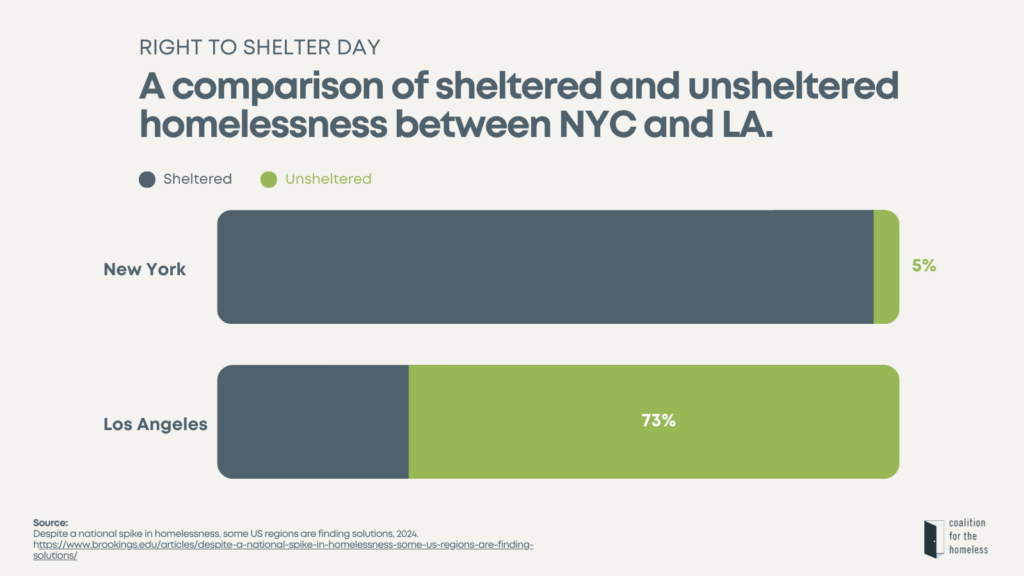December 5, 1979 was a historic day that would transform the lives of countless individuals experiencing homelessness. On that day, the New York State Supreme Court issued its first injunction in the Callahan v. Carey lawsuit and ordered the City and State to provide shelter to homeless adult men. This marked the first in a series of critical victories by the Coalition and The Legal Aid Society that, together, established the “Right to Shelter” for all without homes, making New York unique among American cities.
Forty-five years later, as we commemorate Right to Shelter Day, we explore both its historical significance and its very real impact on the lives of homeless New Yorkers.
The Right to Shelter’s foundation lies in Article XVII of the New York State Constitution, which states that “[t]he aid, care and support of the needy are public concerns and shall be provided by the state… .” This legal protection has, over the years, given more than one million homeless New Yorkers a way off the streets.
The true value of this fundamental protection is best understood through the experiences of those it has helped. “Without legal protection, many people would be living on the streets,” explains Janet, who experienced homelessness firsthand. “These laws protect the homeless from many obstacles.”
“The shelter system may not be the best, but for someone … with nowhere to go, it’s still better than sleeping on the streets.”
Janet’s story highlights how the Right to Shelter extends beyond just providing a bed. Providing a space, however small, to call her own was invaluable. She shared, “it helped me to stand up against discrimination during my search for permanent housing,” simply by offering constant and reliable accommodation, while navigating a consistently unfair and inflexible housing system. Janet was employed full time; however, the systems in place in New York still presented obstacle after obstacle to her obtaining an apartment she could afford.
Eventually, Janet’s persistence paid off, and with the help of the Coalition for the Homeless’ advocacy team, a pathway emerged for her to get out of shelter and into permanent, accessible housing.
Parish, another individual with lived experience, similarly emphasizes the Right to Shelter’s crucial role. “The shelter system may not be the best, but for someone … with nowhere to go, it’s still better than sleeping on the streets,” he said, reflecting on his own experience.
Unlike other major cities with limited shelter capacity and sprawling tent encampments, New York’s Right to Shelter has created a crucial safety net. During New York’s scorching summer days and biting winter nights, as well as crises like the COVID-19 pandemic, this protection has proven life-saving. As Parish notes, “If the right didn’t exist during the outbreak of COVID, and [for] the large amount [sic.] of people coming into the City from other countries, it would have been chaotic.”
Despite what both Janet and Parish acknowledge about the importance of the Right to Shelter, for the past two years the Coalition for the Homeless, with our lawyer at The Legal Aid Society and pro bono counsel, has been fighting against attempts by the City and State to suspend these very rights that have protected and saved the lives of so many. The Coalition and our lawyers were successful in preventing the City and State from using the courts to erode the Right to Shelter in ways that would have been detrimental to both longer term New Yorkers, like Janet and Parish, as well as asylum seekers and other new arrivals. However, the Mayor has promulgated policies like the 30- and 60-day shelter placement limits for asylum seekers that are at odds with Right to Shelter principles. Such policies effectively deny safe and stable shelter to those who need it most, exacerbating the challenges faced by vulnerable individuals and families seeking refuge and a fresh start, plain and simple.
“Putting arbitrary time limits on how long people can stay in shelters is harmful and counterproductive. Instead of continuing to try to undermine New York City’s Right to Shelter, the Mayor and the Governor should create a coordinated strategy to provide people with the services they need to exit shelters into permanent housing so they can build new lives in communities across New York City and State,” said Dave Giffen, Executive Director of the Coalition for the Homeless.
“Immigrants have always been a vital part of New York’s workforce and economy and add to the city’s cultural vibrancy. Ending shelter time limits is a critical step toward helping the newest New Yorkers get on their feet, find work, and build stable lives.”
But working to protect the Right to Shelter is not an end unto itself. While shelter provides immediate safety, as both Janet and Parish emphasize, the City needs long-term solutions. Janet suggests that NYC needs “more affordable rental units based on 30 percent of one’s income.” Parish adds, “The only real solution to the homeless crisis is for the government to build more affordable housing for the people. They can use the stores and office spaces currently unoccupied.”
But working to protect the Right to Shelter is not an end unto itself. While shelter provides immediate safety, as both Janet and Parish emphasize, the City needs long-term solutions. Janet suggests that NYC needs “more affordable rental units based on 30 percent of one’s income.”
Learning about personal stories from individuals like Janet and Parish helps us all understand why these protections are so vital for our city. The Right to Shelter must remain a cornerstone of New York City’s commitment to its most vulnerable residents. As winter approaches, this protection becomes even more crucial, offering not just shelter, but a foundation for rebuilding lives.
This December 5, we say: Right to Shelter protections that have changed the lives of over a million New Yorkers must remain until we can end mass homelessness in our city once and for all.
